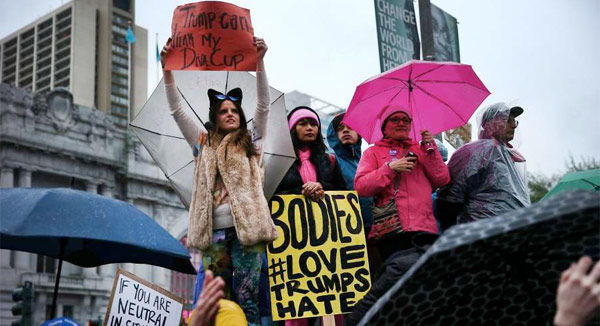News
After the Protests, Marching Toward a Real Movement

As the head of Oakland’s National Nurses United, RoseAnn DeMoro knows how to build movements.
The nurses union, which has nearly 185,000 members, was the early-on-board engine of the Bernie Sanders presidential campaign and led the drubbing of former Gov. Arnold Schwarzenegger in 2005, when he tried to pass four statewide ballot initiatives.
So DeMoro’s take on Saturday’s Women’s March, which drew millions to the streets in 600 cities across the globe, says a lot. “It’s the best organizing moment in our lifetime,” she told me.
But here’s the bad news for progressives: Many in Washington have no idea what to do with that fire hose of energy.
And here’s the good news for progressives: Many in Washington have no idea what to do with that fire hose of energy.
What grassroots activists fear is that politicians will mess it up by trying to contort all those good feelings from march day into something clumsily partisan. Or try to fundraise off of it — your email box is filling with pitches as we speak.
That isn’t what the Women’s March was all about. I say that quite confidently and it comes from what women at the march told me. Many had never been to a march before. So the one question I heard constantly was: “What do I do now?”
I’ve covered dozens of protests, from antiwar demonstrations in San Francisco to the 1995 Million Man March in Washington. Nobody ever asks that question. They come with an agenda.
And that questioning, that searching, is the power of whatever will come out of the marches, not its weakness. People are “woke” like they haven’t been in a decade.
The march’s power is in sisters like Michelle Ward McGee — a retired law enforcement officer from Seattle — and Dedrick Ward, a retired Navy officer from Texas. They are middle-aged women who aren’t typical protesters. But they wanted to be in Washington because they were frustrated and scared about what they were seeing, about what would happen to their sons and their friends and their families. And they wanted to know what to do next.
“It’s inspiring being here,” Ward McGee said. “When I go back home, I’m going to find someplace to help out.”
But they told me that they’re still going to be searching for what to do. They’re gathering in small groups and talking about what they want to do next.
And that’s OK. Everybody is.
Even Sen. Dianne Feinstein. I spoke to her briefly in Washington on the Monday after the march. She didn’t attend — she was out to dinner with her husband for their anniversary — but was approached by marchers in the restaurant.
She was blown away by how enthusiastic and energetic they were. They asked her, “What do we do next?”
“So I told them, ‘Run for office,’” Feinstein told me.
That’s OK, but not for everyone. More interestingly, Feinstein invoked the marchers Wednesday when she asked the Senate Judiciary Committee for a one-week delay in the confirmation hearing of attorney general nominee and GOP Alabama Sen. Jeff Sessions.
The committee needed more time to review 188 newly submitted pages of Sessions’ written responses to questions. But Feinstein also told her fellow members, “I also believe it’s important to reflect on this nomination in light of the demonstration we saw this weekend.” The committee granted her request.
Even senators are searching.
On the night after the Women’s March, I stopped by a party for 700 progressives in Washington. It was informally dubbed the “Blue Ball,” so I figured — about 33 hours after Donald Trump took office — that I’d better get there early before the ballers got sloppy from all that crying in their beer.
Instead, the people were giddy, still high from marching earlier in the day. They weren’t blown away just by the energy they had seen in the Women’s March, but by the millions of people who turned out in cities outside the liberal bubble (12,000 in Oklahoma City!). Suddenly, Democrats and Trump-loathers everywhere had hope, a pulse. The Resistance wasn’t just going to be whistled online.
Some started to compare the Trump Resistance to the anti-Obama Tea Party launched in February 2009. While there were a couple of smaller demonstrations early, the first big Tea Party protests nationally didn’t land until Tax Day that April, when 5,000 people showed up on Schwarzenegger’s lawn in Sacramento.
“This is so far ahead of where the Tea Party was at this time,” Ben Wikler, the Washington director for MoveOn.org, told me.
Yes. Sort of.
The only problem is that the Women’s March isn’t a movement yet. People are still searching about what it means to them. Politicians should let them search — and lead them to the answer.